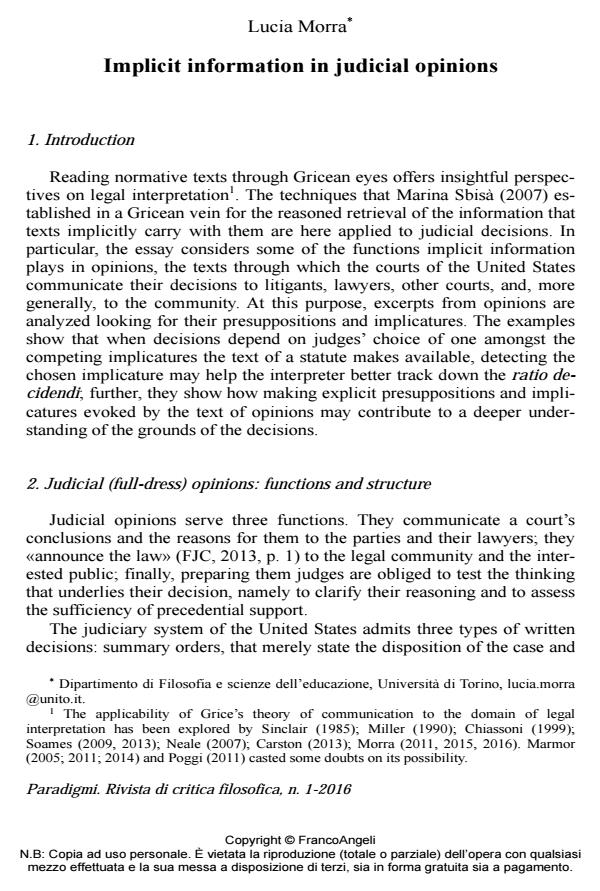Implicit information in judicial opinions
Journal title PARADIGMI
Author/s Lucia Morra
Publishing Year 2016 Issue 2016/1 Language English
Pages 18 P. 81-98 File size 213 KB
DOI 10.3280/PARA2016-001007
DOI is like a bar code for intellectual property: to have more infomation
click here
Below, you can see the article first page
If you want to buy this article in PDF format, you can do it, following the instructions to buy download credits

FrancoAngeli is member of Publishers International Linking Association, Inc (PILA), a not-for-profit association which run the CrossRef service enabling links to and from online scholarly content.
The essay applies to judicial decisions the techniques Sbisà (2007) established for retrieving information that texts implicitly carry with them. In order to consider the functions implicit information plays in these kinds of texts, excerpts from opinions are analyzed looking for their presuppositions and implicatures. The examples show that when decisions depend on judges’ choice of one amongst the competing implicatures the text of a statute makes available, detecting the chosen implicature may help the interpreter better track down the ratio decidendi; further, they show that making explicit presuppositions and implicatures evoked by the text of opinions may contribute to a deeper understanding of the grounds of the decisions.
Keywords: Implicit information, conversational implicature, judicial opinion, legal interpretation, presupposition, statute.
- Id. (2014). The Language of Law. Oxford: Oxford University Press.
- Miller G.P. (1990). Pragmatics and the Maxims of Interpretation. Wisconsin Law Review, 1179: 1179-1227.
- Chiassoni P. (1999). Interpretive Games: Statutory Construction Through Gricean Eyes. In: Comanducci P. e Guastini R., a cura di. Analisi e diritto 1999. Ricerche di giurisprudenza analitica. Torino: Giappichelli: 79-99.
- Elisa B. v. Superior Court, 37 Cal.4th 108 (Cal 2005), 117 P.3d 660, 33 Cal.Rptr.3d 46:
- http://web.lexisnexis.com/research/xlink?app=00075&view=full&interface=1&docinfo=off&searchtype=get&search=37+Cal.+4th+108
- Elisa Maria B. v. Superior Court, 118 Cal. App. 4th 966 (2004): http://www.courts.ca. gov/opinions/revpub/C042077.PDF
- Endicott T. (2005). The Value of Vagueness. In: Bhatia V.K. et al., eds., Vagueness in normative texts. Bern: Peter Lang: 27-48.
- Federal Judicial Center (2013). Judicial Writing Manual: A Pocket Guide for Judges. http://www.fjc.gov/public/pdf.nsf/lookup/judicial-writing-manual-2d-fjc-2013.pdf/$file/judicial-writing-manual-2d-fjc-2013.pdf
- Grice H.P. (1975). Logic and conversation. In Cole P. and Morgan J.L., eds., Syntax and Semantics, Vol. 3: Speech Acts. New York: Academic Press: 41-58.
- Marmor A. (2005). Interpretation and Legal Theory: revised second edition. Oxford and Portland: Hart Publishing. [First edition: Interpretation and Legal Theory, Oxford: Oxford University Press, The Clarendon Law Series, 1992]
- Id. (2008). What Does the Law Say? Semantics and Pragmatics in Statutory Language. In: Comanducci P. e Guastini R., a cura di. Analisi e diritto 2007. Ricerche di giurisprudenza analitica, Torino: Giappichelli: 127-140.
- Id. (2011). Can the Law Imply More than it Says? On some pragmatic aspects of strategic speech. In: Marmor A. and Soames S., eds. Philosophical Foundations of Language in the Law. Oxford: Oxford University Press: 83-97.
- Morra L. (2010). New Models for Language Understanding and the Cognitive Approach to Legal Metaphors. International Journal for the Semiotics of Law, 23, 4: 387-405.
- Id. (2011). Implicature conversazionali nei testi di legge. Esercizi filosofici, 6, 1: 214-231.
- Id. (2015). Genitorialità californiana. In: Morra L. e Pasa B., a cura di. Questioni di genere nei testi normativi: impliciti e crittotipi, Torino: Giappichelli: 181-200.
- Id. (2016). Conversational Implicatures in Normative Texts. In: Mey J.L. and Capone A., eds., Interdisciplinary Studies in Pragmatics, Culture and Society. Dordrecht: Springer.
- Morra L. and Pasa B., a cura di (2015). Questioni di genere nei testi normativi: impliciti e crittotipi. Torino: Giappichelli.
- Neale S. (2007). On Location. In: O’Rourke M. and Washington C., eds., Situating Semantics: Essays in Honor of John Perry. Cambridge: MIT Press: 251-393.
- Pasa B. (2015). Dal crittotipo all’implicito: diritto tacito, muto, vissuto? In: Morra L. e Pasa B., a cura di. Questioni di genere nei testi normativi: impliciti e crittotipi. Torino: Giappichelli: 52-69.
- Poggi F. (2008), Semantics, Pragmatics, and Interpretation: A Critical Reading of Some of Marmor’s Theses. In: Comanducci P. e Guastini R., a cura di. Analisi e diritto 2007. Ricerche di giurisprudenza analitica. Torino: Giappichelli: 159-178.
- Id. (2011). Law and Conversational Implicatures. International Journal for the Semiotics of Law, 24, 1: 21-40.
- Sbisà M. (2007). Detto non detto. Le forme della comunicazione implicita. Roma-Bari: Laterza.
- Id. (2015). Normatività e comunicazione. In: Morra L. e Pasa B., a cura di. Questioni di genere nei testi normativi: impliciti e crittotipi. Torino: Giappichelli: 15-37.
- Sinclair M.B.W. (1985). Law and Language: the Role of Pragmatics in Statutory Interpretation. The University of Pittsburgh Law Review, 46: 373-415.
- Smith v. United States, 508 U.S. 223 (1993): https://supreme.justia.com/cases/ federal/us/ 508/223/case.html
- Soames S. (2009). Interpreting Legal Texts: What is, and What is not, Special about the Law. In: Soames S. Philosophical Essays. 1: Natural language: What it Means and How We Use It. Princeton: Princeton University Press: 403-424.
- Id. (2013). Deferentialism: A Post-Originalist Theory of Legal Interpretation. Fordham Law Review, 82, 2: 597-617.
- Strunk W. Jr. and White E.B. (2000). The Elements of Style (4th ed.). Harlow: Pearson Education Limited.
- Pragmatics and Law Lucia Morra, pp.201 (ISBN:978-3-319-30383-3)
Lucia Morra, Implicit information in judicial opinions in "PARADIGMI" 1/2016, pp 81-98, DOI: 10.3280/PARA2016-001007